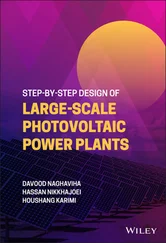4 Chapter 5Table 5.1 Grounding.
5 Chapter 7Table 7.1 Fixtures and switching by area (actual project).Table 7.2 Illumination level for various areas.
6 Chapter 9Table 9.1 ACSR line conductors.Table 9.2 Line characteristics.Table 9.3 Clearance in meters, vertical measurement.Table 9.4 Phase clearances.Table 9.5 Selected conductors.Table 9.6 Shunt capacitance and charging currents for selected circuits.
7 Chapter 10Table 10.1 Standard BIL levels.Table 10.2 Arrester ratings for grounded/ungrounded systems.Table 10.3 IEEE MCOV and IEC ( U k) minimum ratings [6,9]. Table 10.4 Line shielding.Table 10.5 NFPA Std. 780 Material Classifications for Lightning Systems
8 Chapter 11Table 11.1 World's typical voltages.Table 11.2 Nominal low voltages.Table 11.3 Equipment voltages, three phase, AC > 1 kV < 35 kV.Table 11.4 Transmission voltages (kV).
9 Chapter 12Table 12.1 Insulation characteristics.Table 12.2 Cable comparisons in USA and IEC used in Europe and Asia.Table 12.3 NEMA tray class.Table 12.4 CSA load classification (maximum design load for maximum associate...Table 12.5 Cable ampacity.Table 12.6 Cable bus ampacity comparison.
10 Chapter 13Table 13.1 VAR power flow.Table 13.2 Correction needed for 100 kW motor.Table 13.3 Maximum capacitor kVAR for use with 3 ph 60 Hz motors (NEC code).
11 Chapter 14Table 14.1 Supply voltage change.
12 Chapter 15Table 15.1 Motor/cable wave reflection.Table 15.2 Harmonic correction.
13 Chapter 16Table 16.1 Standard PT burdens.Table 16.2 Standard CT burdens.
14 Chapter 17Table 17.1 Machine floor networking.Table 17.2 RG coax characteristics.Table 17.3 UTP cable application.Table 17.4 Ethernet connections.
15 Chapter 18Table 18.1 Capacity factors in the UK.
16 Chapter 20Table 20.1 Diesel engine fuel consumption.Table 20.2 Coolant distribution.Table 20.3 Engine performance, base load.Table 20.4 Engine percentage of loading performance.
17 Chapter 22Table 22.1 Water tank capacity.
18 Chapter 23Table 23.1 Metal solution potentials.Table 23.2 Human health effects by H 2S sponsored by WHO (UN).
19 Chapter 24Table 24.1 Plant phasing diagram.Table 24.2 Transformer insulation class.Table 24.3 NEMA type enclosures.Table 24.4 NEMA Type EnclosuresTable 24.5 NEMA/IEC compatibility.Table 24.6 IP enclosures degree of protection.
20 Chapter 26Table 26.1 Wind classification.Table 26.2 Cable ampacity.Table 26.3 Typical utility interconnection requirements.
1 Chapter 1 Figure 1.1 Project development. Figure 1.2 Cost of change. Figure 1.3 Motor wiring diagram with PLC module. Figure 1.4 Motor wiring diagram to DeviceNet communication module. Figure 1.5 Three‐phase tester. Figure 1.6 Plant handover procedure. Figure 1.7 Plant interlocks, hard wired and software. Figure 1.8 Typical LCOE cost ranges and weighted averages for electricity ge...
2 Chapter 2 Figure 2.1 Part of a plant one line diagram. Figure 2.2 Part of plant flow diagram. Figure 2.3 A part of a P&ID diagram. Figure 2.4 Large oil filled transformer. Figure 2.5 245 kV circuit breaker. Figure 2.6 Double and single incomer diagram. Figure 2.7 Key one‐line diagram. Figure 2.8 Plant MV switchgear. Figure 2.9 4.16 kV motor controller assembly. Figure 2.10 Part of LV switchgear. Figure 2.11 Switchgear breaker interlocks. Figure 2.12 Distribution line. Figure 2.13 Plant phasing diagram. Figure 2.14 Standby generator. Figure 2.15 Lightning arrester. Figure 2.16 BIL impulse wave shape.
3 Chapter 3 Figure 3.1 (a) MV switchgear and (b) circuit breaker. Figure 3.2 Arc flash accident. Figure 3.3 Personal protective equipment. Figure 3.4 MV MCC controller assembly. Figure 3.5 Motor protection chart. Figure 3.6 MV motor controller basic circuit.Figure 3.7 Unit substations for LV distribution.Figure 3.8 (a) LV substation – double ended. (b) LV draw‐out circuit breaker...Figure 3.9 LV breaker adjustable operating curvesFigure 3.10 LV MCC assembly.Figure 3.11 MCC starter bucket.Figure 3.12 A family of circuit breakers [8].Figure 3.13 Breaker time – current characteristic.Figure 3.14 Electronic overload.Figure 3.15 HMCP adjustable breakers.Figure 3.16 Typical motor protection with breakers.Figure 3.17 Motor protected by Fuse.
4 Chapter 4Figure 4.1 Permafrost temperature.Figure 4.2 HV outdoor substation.Figure 4.3 Concrete PVC duct bank.Figure 4.4 Cable duct installation.Figure 4.5 (a and b) Soil heat resistivity charts.Figure 4.6 Prefabricated electrical room.Figure 4.7 Unistrut channels.Figure 4.8 Transformers, fire barrier walls.Figure 4.9 Plant control room.Figure 4.10 CR tile floor.
5 Chapter 5Figure 5.1 Neutral point solid grounding.Figure 5.2 Neutral point resistance grounding.Figure 5.3 Method of grounding and equivalent circuits.Figure 5.4 Unit G grounding.Figure 5.5 Grounding Zg transformer.Figure 5.6 Zg grounding transformer.Figure 5.7 Fault currents in Y/Δ transformer.
6 Chapter 6Figure 6.1 (a) Wenner four‐pin method and (b) three‐point fall of potential ...Figure 6.2 Part of plant grounding grid (mesh).Figure 6.3 Step and touch potential.Figure 6.4 GPR equipotential contours.Figure 6.5 Cadweld underground connections.Figure 6.6 Cadweld connections.Figure 6.7 Rebar connection.Figure 6.8 Mechanical crimp connections.Figure 6.9 Motor base grounding.Figure 6.10 Fence grounding.
7 Chapter 7Figure 7.1 ATS.Figure 7.2 (a) Battery power pack, (b) exit light, and (c) exit light with l...Figure 7.3 Illuminance level (an average illumination of 300 lx was required...Figure 7.4 Light distribution (a) for indoors and (b) for street lighting do...Figure 7.5 Photometric cone diagram.Figure 7.6 Lighting transformers.Figure 7.7 Fluorescent fixture with glare diffuser.Figure 7.8 (a) Industrial fluorescent, (b) roadway LED, and (c) hi‐bay HPS....Figure 7.9 Lighting panel.Figure 7.10 Receptacles (outlets).Figure 7.11 Welding outlet.Figure 7.12 Lamp CRI color rendering code.Figure 7.13 Light color temperature.Figure 7.14 Light spectra.Figure 7.15 Fluorescent, (a) cool and (b) warm.Figure 7.16 LPS lamp.Figure 7.17 LED technology.Figure 7.18 LED beams.
8 Chapter 8Figure 8.1 Battery (a) discharge and (b) charge process.Figure 8.2 Typical battery ampere‐hour capacity and hourly discharge..Figure 8.3 Internal plate connections.Figure 8.4 Battery life and temperature dependency.Figure 8.5 Battery rack.Figure 8.6 Charger and UPS.Figure 8.7 DC system connection diagram.Figure 8.8 Continuous UPS.
9 Chapter 9Figure 9.1 Multicircuit overhead line.Figure 9.2 ACSR conductor.Figure 9.3 (a–d) Types of plant distribution.Figure 9.4 Circuit transition point.Figure 9.5 Relationship between resistance, reactance, and impedance for con...Figure 9.6 Line loading.Figure 9.7 Voltage drop for line load at end of line.Figure 9.8 Voltage drop for not equally distributed load.Figure 9.9 Voltage drop for equally distributed load.Figure 9.10 Line loss calculations.Figure 9.11 ABC cable installation.Figure 9.12 ABC cable composition.
10 Chapter 10Figure 10.1 Arresters in HV substation.Figure 10.2 Lightning strike.Figure 10.3 World isokeraunic map by NASA.Figure 10.4 Test voltage and current waveshapes.Figure 10.5 Impulse wave shape.Figure 10.6 Impulse test connection.Figure 10.7 Ground flash density of USA.Figure 10.8 Equipment withstand capability.Figure 10.9 MV pole arrester.Figure 10.10 MV arrester performance chart.Figure 10.11 V – I chart of a ZnO arrester for 420 kV system with earthed neut...Figure 10.12 Lightning aerial base.Figure 10.13 Air terminal height.Figure 10.14 Protection of low‐rise buildings ≤7.6 m.Figure 10.15 Protection of buildings >15 m.Figure 10.16 Cadweld underground connections.
11 Chapter 11Figure 11.1 World voltage and frequency map.Figure 11.2 CCW phase sequence.Figure 11.3 Three phase power.Figure 11.4 (a, b) Phase sequence based on rotor rotation.Figure 11.5 Changes due to phase sequence error. UAT = unit auxiliary transf...Figure 11.6 World plug map by type.Figure 11.7 World plug and socket types.
Читать дальше












